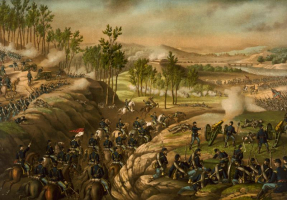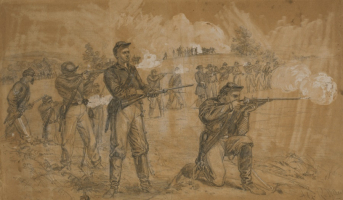Top 6 Facts About The Battle of Brandy Station
The Battle of Brandy Station, also known as the Battle of Fleetwood Hill, was the greatest cavalry combat of the American Civil War and the largest ever fought ... read more...on American territory. It was fought on June 9, 1863, in Brandy Station, Virginia, at the start of the Gettysburg Campaign by Union cavalry under Maj. Gen. Alfred Pleasonton against Confederate cavalry under Maj. Gen. J.E.B. Stuart. Here are some interesting facts about the battle of Brandy Station we compiled for you.
-
The Battle of Brandy Station, also known as the Battle of Fleetwood Hill, was the greatest cavalry of the American Civil War and the largest ever fought on American territory. It was fought on June 9, 1863, in Brandy Station, Virginia, at the start of the Gettysburg Campaign by Union cavalry under Maj. Gen. Alfred Pleasonton against Confederate cavalry under Maj. Gen. J.E.B. Stuart. It was also the first fight of the most renowned campaign of the war, Gettysburg.
The 1863 fight began as a raid before daybreak when 5,500 Union cavalry stormed across the Rappahannock River in an attempt to forestall an impending Confederate raid on the Union supply line. The Confederate army, on the other hand, was on the move, breaking camp to ride north into Pennsylvania.
The skirmish swiftly evolved into an all-out cavalry clash involving 20,000 people, including 17,000 cavalries. Confederate General J.E.B. Stuart and Union General John Buford fought to a draw. Although the Union advance was repulsed, the Confederate cavalry's previously overwhelming supremacy was gone.

battlefields.org 
en.wikipedia.org -
One of the most interesting facts about the Battle of Brandy Station is that the Battle of Brandy Station marked the start of the Gettysburg Campaign. The Gettysburg campaign was a military invasion of Pennsylvania in the summer of 1863 by the main Confederate army led by General Robert E. Lee. It was the Confederate Army's first full-scale invasion of a free state during the war. On July 1-3, the Union scored a resounding victory at Gettysburg, despite terrible fatalities on both sides. Lee and the majority of his force were able to flee to Virginia. It was a watershed moment in the American Civil War, with Lee gradually being pushed back into Richmond until his surrender in April 1865. Maj. Gen. Joseph Hooker led the Union Army of the Potomac until June 28, when he was replaced by Maj. Gen. George G. Meade.
The Battle of Brandy Station occurred just over a month after the Battle of Chancellorsville in early May 1863. Although Chancellorsville was a Confederate triumph, it left the grey army battered and accomplished little to affect Virginia's strategic situation. Recognizing the dangers posed by the Union siege of Vicksburg, Mississippi, the loss of Middle Tennessee, and the desolation of Virginia's countryside, Robert E. Lee launched an invasion of the North on June 2, 1863. He hoped to obtain food and supplies for his starving forces, relieve pressure on other theaters of war, and, at worst, compel peace by annihilating the Army of the Potomac outside of Washington. By May 15, the foremost units of Gen. J.E.B. Stuart's Cavalry Division had advanced into Culpeper to screen Lee's march into the Shenandoah Valley

weaponsandwarfare.com 
charlesewing.com -
Another fact about the battle is that the Confederates had intended for June 9, 1863, to be a day of maneuvering rather than fighting. Two of the army's three infantry corps were near Culpeper, six miles southwest of Brandy Station, preparing to advance up the Shenandoah Valley and into Pennsylvania. Major General J.E.B. Stuart was to screen this operation with his 9,500-man cavalry division at Brandy Station, while the entire infantry corps held the Union Army's attention at Fredericksburg, 35 miles southeast of Brandy Station.
The Federals were aware that Confederate cavalry was in the vicinity of Culpeper, but their intelligence had not obtained information on the substantial infantry force behind the horsemen. Major General Joseph Hooker, commander of the Army of the Potomac, interpreted the presence of enemy cavalry at Culpeper as preparations for a raid on his army's supply lines. As a result, he directed Brigadier General Alfred Pleasonton, commander of his Cavalry Corps, to break up Stuart's raid in its infancy.
The Confederates obviously did not anticipate any harassment from the enemy cavalry, for the day before the crucial screening operation, the Southern troops held a grand review for General Robert E. Lee at Inlet Station, just two miles southwest of Brandy Station.

nps.gov 
starexponent.com -
One of the most interesting facts about the Battle of Brandy Station is that in the three weeks leading up to the Battle of Brandy Station, J.E.B. Stuart held three reviews, exasperating his troops and disclosing his whereabouts to Union scouts. J.E.B. Stuart gathered his cavalry for inspection on the southern banks of the Rappahannock River on May 22, June 5, and June 8. But the inspection of ten thousand warriors needed a great deal of effort from both man and beast. Stuart also enjoyed extravagance, so on June 5 he added a great party and a mock battle demonstration to the evaluations. Union officers carefully studied these performances. General John Buford of the Union had his concerns about the Confederate cavalry assembling close to Culpeper, Virginia, and those fears were confirmed by the sound of cannon fire from the fictitious fight.
The day before the fight, on June 8, during the review, Confederate Gen "no doubt the Yankees...have witnessed from their signal stations, this show in which Stuart has exposed to view his strength and aroused their curiosity. They will want to know what is going on and if I am not mistaken, will be over early in the morning to investigate". They will be interested in finding out what is happening and, if I'm not mistaken, will visit early in the morning to look into it." Pleasonton continued to believe that Stuart was in Culpeper, thus Jones was mistaken about the Federal intelligence, but he would undoubtedly run into the enemy in the morning.

battlefields.org 
thewarinamericanhistory.files.wordpress.com -
It is a fact that though the Battle of Brandy Station is known as the largest cavalry battle of the American Civil War, the aftermath of the battle is frequently overlooked. Union casualties totaled 907 (69 killed, 352 wounded, and 486 missings, mostly taken); Confederate casualties totaled 523. This was the largest mainly cavalry fight of the war, involving around 20,500 soldiers. Rooney Lee, Robert E. Lee's son, was among the victims, having been gravely wounded in the thigh. On June 26, he was apprehended at Hickory Hill, an estate near Hanover Court House.
The fields suffered significant losses of soldiers, horses, and mortars, and they were no strangers to the armies of blue and grey. On June 9, 1863, almost 20,000 horsemen clashed on fields and hillsides just northeast of Culpeper, Virginia. Almost 1,500 troops were killed, captured, injured, or went missing as a result of the battle. Captain William W. Blackford, an assistant to General J.E.B Stuart, remembered the devastation, saying afterward, "Fleetwood Hill was covered so thickly after the battle with dead horses and men that there was no room to pitch the tents among them". Morris Schaff, a Union soldier, would later describe an evening spent on the Brandy Station battlefield, saying, "my tent at the station, pitched after dark and partly floored, I discovered later was over the grave of someone who had fallen in those repeated charges."
In the hours following the battle, Confederate troops set to work burying friend and foe alike, precisely where they fell. Men were buried on the battlefields where they had fought. A fortunate handful was later transported to the Culpeper National Cemetery, where they rest beside their comrades who died in the battles of Cedar Mountain, Trevillian's Station, and Gordonsville. Many people's identities are unknown.

weaponsandwarfare.com 
rvanews.com -
One of the most interesting facts about the Battle of Brandy Station is thatIt is a fact that the Brandy Station Foundation (BSF) was established to promote the development of the Brandy Station Battlefield. The organization grew to over 400 members over time and has been the cornerstone of efforts to prevent the battlefield from being turned into an office park and a racetrack, as well as conserving the historic Graffiti House. The National Park Service finished documenting the historic resources at Brandy Station in 1990 and proposed the preservation of 1,262 acres in four distinct engagement zones.
The American Battlefield Trust, formerly The Civil War Trust, has been the primary preservation group at Brandy Station. From 1997 to November 2021, the Trust, with the help of the BSF and other partners, acquired and maintained 2,159 acres of the battlefield in more than 15 different acquisitions. This resulted in the 2003 inauguration of Brandy Station Battlefield Park, which interprets the site's history. This work has prevented a number of commercial ventures, including a proposed Formula One racetrack in the late 1990s, from encroaching on the battleground. The Trust made a notable preservation triumph in 2013 when it purchased a 61-acre parcel at Fleetwood Hill, the location of many critical cavalry charges during the battle. Virginia agreed in 2022 to take 1700 acres from the Trust and up to 800 additional acres to create the Culpeper Battlefields State Park. On July 1, 2024, the Park is scheduled to open.

The site of the battle -en.wikipedia.org 
Graffiti House -en.wikipedia.org



























